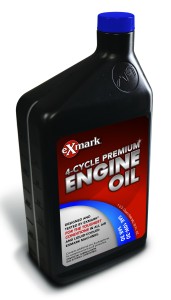There’s nothing more important for extending the life of your mower than proper maintenance, whether it’s pre-season maintenance, in-season maintenance or fall/winter maintenance. Since summer is officially over (already?), we thought this would be the perfect time to focus on fall maintenance. You want your mower to be ready for the long, cold days ahead. Since the list is long, we’ll break up maintenance into two posts, so make sure you come back for the sequel.
A good cleaning.
Storing a clean mower is key. Your mower’ worked hard all summer long and deserves a good wash down. Which brings us to our first cleaning tip: never wash your mower with water or solvents. Water on steel results in rust and deterioration. Clean your mower with air. A leaf blower is a great way to clean a mower, or you can use compressed air.
Make sure you clean everywhere – lift up the seat, get under the deck, reach behind the tires, remove belt guards and clean the area underneath, really get into every nook and cranny. Any debris left on the mower can do one of two things: become a rodent nest or trap moisture. If you’ve already forgotten the first tip we gave you, here’s a recap: steel + water = rust.
Grease is good.
Your mower has bearings that need to be greased. This is the time to do it. Make sure you’re not only starting with fresh grease, but also using the right kind of grease for your machine and conditions. Your Exmark dealer will be able to help you in picking out the appropriate grease.
The greasing technique for the bearings is extremely important. In other words, don’t hurry through it or use shortcuts. Make sure you remove the load before you grease the bearings. If you try to grease bearings while they’re still under load, you’ll end up greasing only half the bearing. It’s worth your while to take your time and remove any belts and springs before employing the grease gun. If the bearing is moveable, we recommend that you move it three or four times to get a nice coating on the bearing. This is also a good way to inspect the bearings for wear and tear, making sure they move freely without any grinding or tightness.
Oil change
Like your car, your mower needs its engine oil and filter changed. It also needs its hydraulic fluid and filter changed. Once all of the fluids and filters have been changed, start the machine for about five minutes or less to make sure the clean engine oil circulates throughout the machine. Utilize the hydraulics to get the fresh fluid circulating as well. If changing your mower’s fluids isn’t your strong suit, take your mower to your dealer. Most dealers run a winterization special during this time of year. One of the benefits of having your dealer perform end of season maintenance is that they usually have a multipoint inspection of the machine that examines multiple wear points, catching something you may miss or not even think about checking. If they do find something, winter is probably the ideal time to have your mower serviced, since you won’t need it in the field.
That’s it our first segment of fall maintenance. Check back soon to see more tips on what you need to do to maintain your mower.
This blog post is by David Martin, customer service manager at Exmark.

 It’s true we have multiple posts discussing lubrication. (
It’s true we have multiple posts discussing lubrication. (




